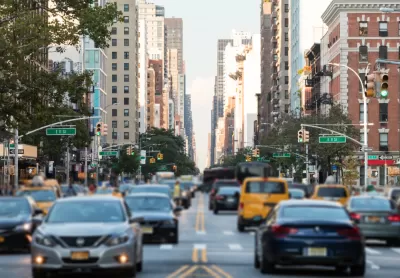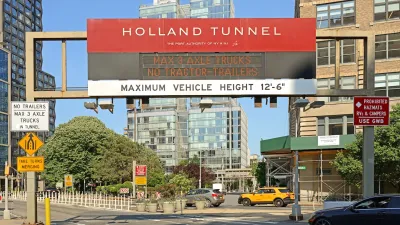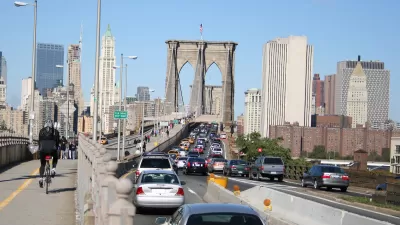The program, which calls for a $15 fee for most vehicles, requires a final MTA board vote in two months.

New York City’s congestion pricing program is moving forward with a $15 fee on passenger vehicles, reports Stephen Nessen in Gothamist, after the MTA board voted to approve it. The program now enters a 60-day public comment period before a final vote.
Nessen points out that “The stakes are high for the program. Congestion pricing has been successfully implemented in other countries. But the MTA’s program represents the first effort in the United States to impose a fee to reduce gridlock.” Additionally, “The tolls are required by law to back $15 billion worth of loans, which accounts for nearly a third of the MTA's 2020-2024 construction program.”
The program includes exemptions and fare discounts for low-income drivers, emergency vehicles, and drivers who already pay certain tolls. “Small trucks, buses and vans face a $24 charge during those hours, while large trucks, including big rigs, will have to pay $36. Motorcycles will be tolled a $7.50 daytime fee.” The fee is reduced by 75 percent during nighttime hours.
FULL STORY: MTA board approves congestion pricing tolls, initiating 60-day review

Trump Administration Could Effectively End Housing Voucher Program
Federal officials are eyeing major cuts to the Section 8 program that helps millions of low-income households pay rent.

Planetizen Federal Action Tracker
A weekly monitor of how Trump’s orders and actions are impacting planners and planning in America.

Ken Jennings Launches Transit Web Series
The Jeopardy champ wants you to ride public transit.

California Invests Additional $5M in Electric School Buses
The state wants to electrify all of its school bus fleets by 2035.

Austin Launches $2M Homelessness Prevention Fund
A new grant program from the city’s Homeless Strategy Office will fund rental assistance and supportive services.

Alabama School Forestry Initiative Brings Trees to Schoolyards
Trees can improve physical and mental health for students and commnity members.
Urban Design for Planners 1: Software Tools
This six-course series explores essential urban design concepts using open source software and equips planners with the tools they need to participate fully in the urban design process.
Planning for Universal Design
Learn the tools for implementing Universal Design in planning regulations.
Ada County Highway District
Clanton & Associates, Inc.
Jessamine County Fiscal Court
Institute for Housing and Urban Development Studies (IHS)
City of Grandview
Harvard GSD Executive Education
Toledo-Lucas County Plan Commissions
Salt Lake City
NYU Wagner Graduate School of Public Service





























